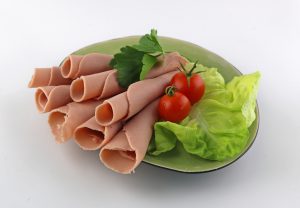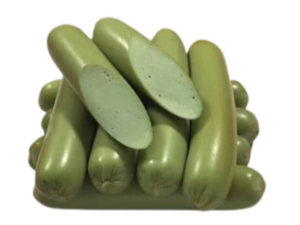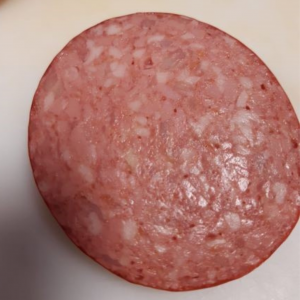Smoked sausages
Nothing improves the flavour of a sausage in a such a rapid and inexpensive way as submitting it to a smoking process. In countries such as Germany and Poland smoked meats account for 60% of all ready to eat meat products. In the USA the variety of sausages carried in supermarkets pale in comparison with their European counterparts. Statistically, smoked sausages control a large share of the American market but most of the credit goes to emulsified and lightly smoked sausages such as the following cooked/smoked sausages, Hotdogs, Frankfurters, or Bolognas. Today, the manufacture of smoked sausages conforms to different criteria and smoke is added purely for the love of the flavour. Many products are not smoked with hardwood at all but receive liquid smoke instead. This is accomplished by adding liquid smoke during mixing or showering sausages with a liquid smoke spray. As the synthetic casings can be ordered in mahogany colour, to the untrained person such a liquid smoke enriched sausage can easily pass as the original.
In the past sausages were smoked for different reasons. Our ancestors did not care much about the flavour of the meat or the sausage. What they needed was a method that would preserve food for later use. They tried different ways to preserve meat and this eventually led to methods like salt curing, drying, smoking and fermenting. It was discovered that salted meats could be air dried and would keep for a long time. Soon two different methods of drying developed. In Northern European countries, winters were cold, and the only way meat could be dried at low temperatures was placing them close to the fire. Originally that took place in caves where fire was the centre of all social activities, then separate enclosures (smokehouses) were built for drying and storing meats. As the temperature had to be higher than freezing temperatures outside, the fire was slowly burning on the ground providing suitable temperatures for drying. It is common knowledge that fire produces smoke and the meats and sausages were dried and smoked at the same time. They were just flavoured with cold smoke for long time which not only further preserved the product but gave it a wonderful aroma. In addition, it prevented moulds from growing on the surface. Those advantages of applying smoke were not ignored by our ancestors and smoking became the art. This does not deny the fact that the main method was drying, and the benefits of smoke was just a bonus.
This can be easily observed by studying drying methods in Southern Europe. The moderate climate was less humid, the slightly blowing winds were ever present and meats were easily dried in the open air for most of the year. There was hardly any need for burning fires and hams and sausages were produced by drying. Spanish chorizos or Italian salamis were made by drying and meat smoking never became so popular as in the North.
Drying meats and sausages
Drying meats and sausages is mainly affected by:
- Humidity – higher humidity, slower drying
- Temperature – higher temperature, faster drying
- Air flow – faster air speed, faster removal of moisture
Conditioning smoked sausages
Conditioning is a short drying process which is employed during manufacture of smoked sausages. This is the drying/setting step which at the first look seems to be insignificant but, it is very important. Stuffed sausages may contain meat that was not cured at all or only partially cured. Leaving sausages for 12 hours at 2-6°C or for 2-3 hours at temperatures below 30°C will provide extra time to fully cure the meat. The products can be placed in a drafty area and moderate use of a fan will be of some help. Air-fan drying should not be used for an extended period as it may harden the surface of the smaller meat pieces/sausages.
This is a short, hardly noticeable process and when making a lot of sausages, before the last casings are stuffed, the first ones are ready for smoking. It is recommended to follow this setting process with smoking as we don’t have to worry about refrigeration of the sausages after they are stuffed. Stuffed sausages that are subject to smoking follow a drying procedure which can last from 0.5-2 hrs at 20-30° C. The time depends on the diameter of the sausage and the amount of moisture it contains. This simple process dries out the surface of the casing so it can acquire smoke better and develop the proper smoking colour. This drying process is often performed inside the smoker and lasts about 1 hr (no smoke applied) at 40-54°C until the casings feel dry. Leave draft controls or the top of your smoker fully open. If natural wood is used for fuel, enough wood must be burned to produce enough hot embers that would be releasing heat without creating smoke to dry out the casings. Preheating a smoker to eliminate the humidity inside is a must step for the smoking process that follows.





